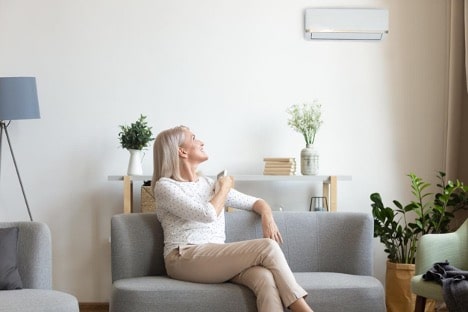There’s nothing that can beat an older home for charm and character. That is, until you realize that no amount of blankets and wool socks are going to keep you warm in the winter, and no amount of popsicles and ice cream are going to cool you off in the summer.
It’s a dilemma that many owners of older homes face, but it’s not insurmountable. With a few upgrades, you can have your beautiful, old home and year-round comfort too.
Here’s how.
How to Heat an Older Home
1. Seal Gaps Around Windows and Doors.
A lot of cold air enters an older home through cracks around windows and doors. Caulking window gaps and weather-stripping the bottom of doors are simple, effective ways of increasing your house’s temperature.
Another option is a draft stopper (also called a door snake). This is a fabric tube filled with insulation that’s placed at the base of your door. It’s a quick fix for blocking drafts that sneak in under doors.
Try filling in your floorboards too. This can be done with wood filler, putty or caulk and will prevent drafts from coming through your floor.
2. Upgrade Your Windows.
Does your home have single-pane windows? These are windows that are made of only one layer of glass and lack insulation, so they’re not effective at keeping cold air out. Consider replacing them with double-pane windows for energy efficiency.
Double-pane windows have two panes of glass with argon, an insulating gas, in between. Some manufacturers also make triple-pane glass. Similar to layering clothes to keep warm, the more layers of glass there are, the warmer your house will be.
3. Use Insulated Curtains.
Insulated curtains are designed to shield your older home from cold air. Under their decorative outer layer, they contain high-density foam, reflective film and a vapor barrier, which provide formidable obstruction against drafts and heat loss.
These curtains also help muffle outside noise and are almost completely opaque, so you can stay warm and sleep soundly too.
4. Insulate Your House.
After years and years of old insulation shifting, sagging and generally deteriorating, your older home is probably extremely drafty. Simply replacing insulation (or adding insulation if there is none) can make a world of difference in providing cold weather comfort.
Some of the other reasons why it pays to insulate an old house include:
- It reduces the likelihood of water condensing on walls and ceilings, preventing the formation of black mold.
- It increases your home’s energy efficiency.
- It helps your house retain heat longer.
How to Cool an Older Home
1. Install a Ductless Mini-Split HVAC.
A ductless mini-split system is an excellent cooling option for an older home. A mini-split is perfect for houses that were built without ductwork. They’re simply installed in the house and connected to an exterior heat pump. A mini-split is very energy-efficient too.
Another advantage is that you can typically purchase up to four air handlers. They can be zoned so that each has its own thermostat and can be set for different cooling preferences.
2. Install Radiant Barriers on Ductwork.
If your home does have ductwork, and it’s located in an attic or crawlspace, it’s probably absorbing a lot of heat (poorly ventilated attics can reach 150 degrees) and transporting it into your home.
A radiant barrier, which is an extremely reflective material that reduces heat transfer, can prevent this from happening, and help your older home stay cool.
3. Install Ceiling Fans.
A ceiling fan will drop a room’s temperature by four to six degrees. That may not sound like much, but it will definitely feel more comfortable. Be sure to set the blades to spin counterclockwise. This way, it pushes cool air downward and improves air circulation. Ceiling fan direction can be reversed by manually flipping a switch on the unit or by remote control.
4. Add a High-Velocity HVAC.
Many old homes don’t have the space for central air conditioning ductwork. Rather than tearing your home apart to accommodate conventional ductwork, try adding a high-velocity HVAC. These systems use ducts that are much smaller than typical ones, so they take up less space and are easier to install.
Contact Us
An older home can be a charming alternative to a mass-produced, cookie-cutter tract home. However, that charm can also be quirky: the house can be hard to heat, hard to cool, or both. At Progressive Air Systems, we have 36 years of experience successfully resolving HVAC issues in classic homes like yours.
Please call us today, and we’ll put the youth back in your home’s heating and cooling systems.

